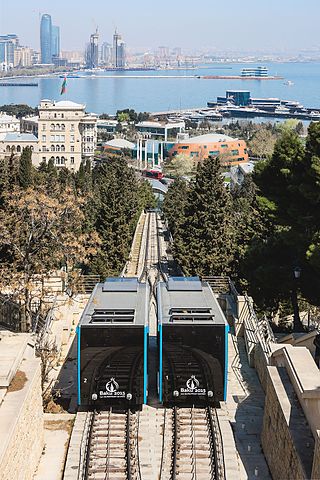
A funicular is a type of cable railway system that connects points along a railway track laid on a steep slope. The system is characterized by two counterbalanced carriages permanently attached to opposite ends of a haulage cable, which is looped over a pulley at the upper end of the track. The result of such a configuration is that the two carriages move synchronously: as one ascends, the other descends at an equal speed. This feature distinguishes funiculars from inclined elevators, which have a single car that is hauled uphill.
Monongahela or Mon Valley may refer to:
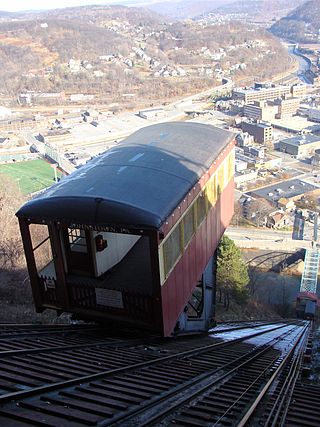
The Johnstown Inclined Plane is a 896.5-foot (273.3 m) funicular in Johnstown, Cambria County, in the U.S. state of Pennsylvania. The incline and its two stations connect the city of Johnstown, situated in a valley at the confluence of the Stonycreek and the Little Conemaugh rivers, to the borough of Westmont on Yoder Hill. The Johnstown Inclined Plane is billed as the "world's steepest vehicular inclined plane". It can carry automobiles and passengers, up or down a slope with a grade of 71.9%. The travel time between stations is 90 seconds.

The Smithfield Street Bridge is a lenticular truss bridge crossing the Monongahela River in Pittsburgh, Pennsylvania, USA.

The Duquesne Incline is a funicular located near Pittsburgh's South Side neighborhood, scaling Mt. Washington in the United States. Designed by Hungarian-American engineer Samuel Diescher, the incline was completed in 1877.

The Lookout Mountain Incline Railway is a 4 ft 8+1⁄2 instandard gauge inclined plane funicular railway leading to the top of Lookout Mountain from the historic St. Elmo neighborhood of Chattanooga, Tennessee. Passengers are transported from St. Elmo's Station at the base, to Point Park at the mountain summit, which overlooks the city and the Tennessee River. It is just a short drive to three of Chattanooga's main tourist attractions, Ruby Falls, Cavern Castle, and Rock City. The railway is approximately one mile (1.6 km) in length. It has a maximum grade of 72.7%, making it one of the world's steepest passenger railways. It obtained Historic Mechanical Engineering Landmark status in 1991. The cable system for the cars was made by the Otis Elevator Company.

Pittsburgh, surrounded by rivers and hills, has a unique transportation infrastructure that includes roads, tunnels, bridges, railroads, inclines, bike paths, and stairways.
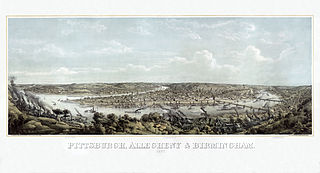
In 1763, King George III provided John Ormsby approximately 2,400 acres (9.7 km2) along the south bank of the Monongahela River as payment for his services during the French and Indian War. The land was then divided into four boroughs: South Pittsburgh, Birmingham, East Birmingham, and Ormsby. The four boroughs were annexed into the City of Pittsburgh in 1872. These areas, collectively, provided for the foundation of the South Side as it is known today.

The South Shore is a neighborhood in Pittsburgh, Pennsylvania South Side. The South Shore consists of the area surrounding Carson Street, from the West End Bridge to the Liberty Bridge.

The Castle Shannon Incline was a funicular railroad in Pittsburgh, Pennsylvania. It was originally part of the Pittsburgh and Castle Shannon Railroad route to the suburb of Castle Shannon. It replaced an earlier incline dating to 1825 that brought coal down from a mine in Mount Washington.
Samuel Diescher was a prominent Hungarian-American civil and mechanical engineer who had his career in the United States. After being educated at universities in Karlsruhe and Zurich in Europe, he immigrated to the United States in 1866 and settled in Cincinnati, Ohio. There he supervised construction of his first inclined plane. He later moved to Pittsburgh, Pennsylvania, where he worked with John Endres on the Monongahela Incline (1870), the first passenger incline in the city.

The Mount Oliver Incline was a funicular on the South Side of Pittsburgh, Pennsylvania. It was designed in 1871 by the Prussian-born engineer John Endres and his American daughter Caroline Endres, one of the first women engineers in the United States.
Caroline Endres Diescher, also known as Caroline Endres, was notable as one of the first female engineers in the United States. With her father John Endres, who was born and educated in Prussia, she designed two inclines in the Pittsburgh area: the Monongahela Incline and the Mount Oliver Incline, which opened in 1870 and 1871, respectively.
The Pittsburgh and Castle Shannon Tunnel, also known as the Mount Washington Coal Tunnel, was a 3 ft 4 in narrow-gauge railway tunnel under Mt. Washington.
John J. Endres was a civil engineer known for designing the Monongahela Incline, the first passenger incline in the United States, in Pittsburgh, Pennsylvania. The incline was originally steam powered and ran on wooden tracks. Born in Prussia and educated in Europe, Endres had immigrated to the United States and settled in Cincinnati, Ohio. His daughter, Caroline Endres, born and educated in the US, became one of the first women engineers in the country. She assisted him on the Monongahela Incline.

Pittsburgh and Castle Shannon Plane was a 3 ft 4 in narrow gauge incline railway that ran from the northern end of the Pittsburgh and Castle Shannon Tunnel to Carson Street in Pittsburgh, Pennsylvania. Originally built to carry coal from the Jacob Beltzhoover mine, it was sold by the Pittsburgh Coal Company to the Pittsburgh and Castle Shannon Railroad in 1871. It was used only for coal as early as 1864, passenger traffic was added in 1874 for the Pittsburgh and Castle Shannon Railroad. For safety reasons, the tunnel was closed to passenger traffic, and passengers were diverted to the Castle Shannon Incline, constructed in 1890. Emergency use of the plane for passengers and freight continued as late as 1900. Its use for the transport of passengers and freight other than coal was made obsolete by the Mount Washington Transit Tunnel. Operation as a coal incline continued until May 1, 1912. It was operated as a gravity plane, with returning empty cars being pulled to the mine mouth by the weight of the descending full coal cars.
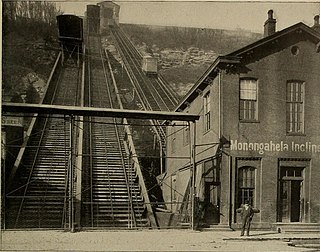
The Monongahela Freight Incline was a funicular railway that scaled Mount Washington in Pittsburgh, Pennsylvania, United States.

Originally, various track gauges were used in the United States. Some railways, primarily in the northeast, used standard gauge of 4 ft 8+1⁄2 in ; others used gauges ranging from 2 ft to 6 ft. As a general rule, southern railroads were built to one or another broad gauge, mostly 5 ft, while northern railroads that were not standard-gauge tended to be narrow-gauge. The Pacific Railroad Acts of 1863 specified standard gauge.
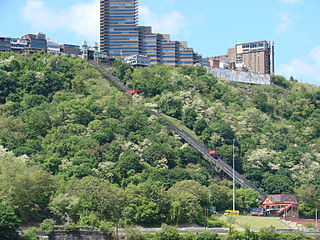
Mount Washington is a hill in Pittsburgh, on the southern banks of the Monongahela River and Ohio River.


























